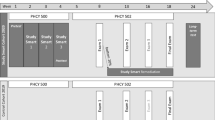Abstract
Despite recent advances in undergraduate medical education, integration of vertical curricula and simultaneous delivery of competencies remain challenging. To address this educational challenge, we delivered a series of case-based exercises to a combined class of M1 and M2 students to achieve vertical (year-to-year) and horizontal (clinical and basic science) integration. These exercises consisted of a case, concept mapping activity to link basic science content to an underlying symptom, and follow-up discussion. Following the activities, students were asked to complete a survey evaluating the effectiveness of their experience including level of learning, effectiveness of peer teaching, and incorporation of core competencies. Overall, the students described the activity positively (informative and engaging). M1 students reported regularly helping M2 students review the M1 material. Unsurprisingly, the M2 students assisted the M1 students with the M2 material to a greater extent and significantly improved the M1 students’ confidence with that material. The M2 students generally felt successful in peer teaching but reported that it regularly revealed intrinsic knowledge gaps. As important, this activity reportedly addressed competencies in addition to Medical Knowledge, specifically Communication Skills, Practice-Based Learning, and Professionalism. In summary, this learning activity provided opportunities for students to (1) refine clinical reasoning and peer-peer teaching skills, (2) reinforce the basic science content within a clinical context, and (3) integrate several additional key core competencies into the heavily Medical-Knowledge-focused pre-clerkship curriculum. This novel activity facilitated vertical and horizontal integration of several key core competencies in a manner that could be incorporated and assessed in nearly any curricular structure.


Similar content being viewed by others
References
Cooke M, Irby DM, Sullivan W, Ludmerer KM. American medical education 100 years after the Flexner report. N Engl J Med. 2006;355(13):1339–44. doi:10.1056/NEJMra055445.
Harris P, Snell L, Talbot M, Harden RM. Competency-based medical education: implications for undergraduate programs. Med Teach. 2010;32(8):646–50. doi:10.3109/0142159X.2010.500703.
Malau-Aduli BS, Lee AY, Cooling N, Catchpole M, Jose M, Turner R. Retention of knowledge and perceived relevance of basic sciences in an integrated case-based learning (CBL) curriculum. BMC Med Educ. 2013;13:139. doi:10.1186/1472-6920-13-139.
Englander R, Cameron T, Ballard AJ, Dodge J, Bull J, Aschenbrener CA. Toward a common taxonomy of competency domains for the health professions and competencies for physicians. Acad Med. 2013;88(8):1088–94. doi:10.1097/ACM.0b013e31829a3b2b.
Thompson BM, Schneider VF, Haidet P, Levine RE, McMahon KK, Perkowski LC, et al. Team-based learning at ten medical schools: two years later. Med Educ. 2007;41(3):250–7. doi:10.1111/j.1365-2929.2006.02684.x.
Wingelaar TT, Wagter JM, Arnold AE. Students’ educational needs for clinical reasoning in first clerkships. Perspect Med Educ. 2012;1(2):56–66. doi:10.1007/s40037-012-0010-7.
Rider EA, Keefer CH. Communication skills competencies: definitions and a teaching toolbox. Med Educ. 2006;40(7):624–9. doi:10.1111/j.1365-2929.2006.02500.x.
Frank JR, Danoff D. The CanMEDS initiative: implementing an outcomes-based framework of physician competencies. Med Teach. 2007;29(7):642–7. doi:10.1080/01421590701746983.
Michaelsen LK, EBSCOhost (Online Service). Team-based learning for health professions education a guide to using small groups for improving learning. 1st ed. VA: Sterling; 2008. Stylus.
Friedlander MJ, Andrews L, Armstrong EG, Aschenbrenner C, Kass JS, Ogden P, et al. What can medical education learn from the neurobiology of learning? Acad Med. 2011;86(4):415–20. doi:10.1097/ACM.0b013e31820dc197.
D’Mello S, Graesser A. Confusion and complex learning during interactions with computer learning environments. Internet Higher Educ. 2012;15(3):184–94.
Prober CG, Heath C. Lecture halls without lectures—a proposal for medical education. N Engl J Med. 2012;366(18):1657–9. doi:10.1056/NEJMp1202451.
Koles PG, Stolfi A, Borges NJ, Nelson S, Parmelee DX. The impact of team-based learning on medical students’ academic performance. Acad Med. 2010;85(11):1739–45. doi:10.1097/ACM.0b013e3181f52bed.
Thompson BM, Schneider VF, Haidet P, Perkowski LC, Richards BF. Factors influencing implementation of team-based learning in health sciences education. Acad Med. 2007;82(10 Suppl):S53–6. doi:10.1097/ACM.0b013e3181405f15.
Michaelsen LK, Sweet M, Parmelee DX. Team-based learning: small group learning’s next big step. New directions for teaching and learning, vol no 116. San Francisco: Jossey-Bass; 2008.
Dannefer EF, Henson LC. The portfolio approach to competency-based assessment at the Cleveland Clinic Lerner College of Medicine. Acad Med. 2007;82(5):493–502. doi:10.1097/ACM.0b013e31803ead30.
Driessen E, van der Vleuten C, Schuwirth L, van Tartwijk J, Vermunt J. The use of qualitative research criteria for portfolio assessment as an alternative to reliability evaluation: a case study. Med Educ. 2005;39(2):214–20. doi:10.1111/j.1365-2929.2004.02059.x.
van Gessel E, Nendaz MR, Vermeulen B, Junod A, Vu NV. Development of clinical reasoning from the basic sciences to the clerkships: a longitudinal assessment of medical students’ needs and self-perception after a transitional learning unit. Med Educ. 2003;37(11):966–74.
Levine RE, O’Boyle M, Haidet P, Lynn DJ, Stone MM, Wolf DV, et al. Transforming a clinical clerkship with team learning. Teach Learn Med. 2004;16(3):270–5. doi:10.1207/s15328015tlm1603_9.
Author information
Authors and Affiliations
Corresponding author
Rights and permissions
About this article
Cite this article
LeClair, R., Binks, A.P. Combining the M1 and M2 Classroom: an Effective Method for Vertical and Horizontal Integration of Core Competencies. Med.Sci.Educ. 26, 77–83 (2016). https://doi.org/10.1007/s40670-015-0196-5
Published:
Issue Date:
DOI: https://doi.org/10.1007/s40670-015-0196-5



